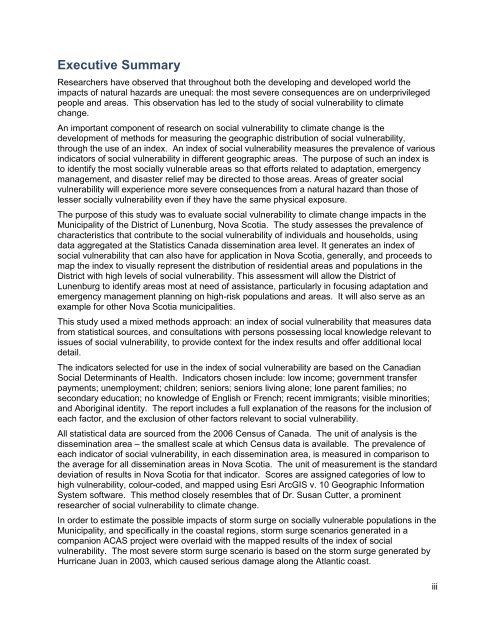Lunenburg Part 2 - Section 5 - Social Vulnerability - August 30.pdf
Lunenburg Part 2 - Section 5 - Social Vulnerability - August 30.pdf
Lunenburg Part 2 - Section 5 - Social Vulnerability - August 30.pdf
Create successful ePaper yourself
Turn your PDF publications into a flip-book with our unique Google optimized e-Paper software.
Executive Summary<br />
Researchers have observed that throughout both the developing and developed world the<br />
impacts of natural hazards are unequal: the most severe consequences are on underprivileged<br />
people and areas. This observation has led to the study of social vulnerability to climate<br />
change.<br />
An important component of research on social vulnerability to climate change is the<br />
development of methods for measuring the geographic distribution of social vulnerability,<br />
through the use of an index. An index of social vulnerability measures the prevalence of various<br />
indicators of social vulnerability in different geographic areas. The purpose of such an index is<br />
to identify the most socially vulnerable areas so that efforts related to adaptation, emergency<br />
management, and disaster relief may be directed to those areas. Areas of greater social<br />
vulnerability will experience more severe consequences from a natural hazard than those of<br />
lesser socially vulnerability even if they have the same physical exposure.<br />
The purpose of this study was to evaluate social vulnerability to climate change impacts in the<br />
Municipality of the District of <strong>Lunenburg</strong>, Nova Scotia. The study assesses the prevalence of<br />
characteristics that contribute to the social vulnerability of individuals and households, using<br />
data aggregated at the Statistics Canada dissemination area level. It generates an index of<br />
social vulnerability that can also have for application in Nova Scotia, generally, and proceeds to<br />
map the index to visually represent the distribution of residential areas and populations in the<br />
District with high levels of social vulnerability. This assessment will allow the District of<br />
<strong>Lunenburg</strong> to identify areas most at need of assistance, particularly in focusing adaptation and<br />
emergency management planning on high-risk populations and areas. It will also serve as an<br />
example for other Nova Scotia municipalities.<br />
This study used a mixed methods approach: an index of social vulnerability that measures data<br />
from statistical sources, and consultations with persons possessing local knowledge relevant to<br />
issues of social vulnerability, to provide context for the index results and offer additional local<br />
detail.<br />
The indicators selected for use in the index of social vulnerability are based on the Canadian<br />
<strong>Social</strong> Determinants of Health. Indicators chosen include: low income; government transfer<br />
payments; unemployment; children; seniors; seniors living alone; lone parent families; no<br />
secondary education; no knowledge of English or French; recent immigrants; visible minorities;<br />
and Aboriginal identity. The report includes a full explanation of the reasons for the inclusion of<br />
each factor, and the exclusion of other factors relevant to social vulnerability.<br />
All statistical data are sourced from the 2006 Census of Canada. The unit of analysis is the<br />
dissemination area – the smallest scale at which Census data is available. The prevalence of<br />
each indicator of social vulnerability, in each dissemination area, is measured in comparison to<br />
the average for all dissemination areas in Nova Scotia. The unit of measurement is the standard<br />
deviation of results in Nova Scotia for that indicator. Scores are assigned categories of low to<br />
high vulnerability, colour-coded, and mapped using Esri ArcGIS v. 10 Geographic Information<br />
System software. This method closely resembles that of Dr. Susan Cutter, a prominent<br />
researcher of social vulnerability to climate change.<br />
In order to estimate the possible impacts of storm surge on socially vulnerable populations in the<br />
Municipality, and specifically in the coastal regions, storm surge scenarios generated in a<br />
companion ACAS project were overlaid with the mapped results of the index of social<br />
vulnerability. The most severe storm surge scenario is based on the storm surge generated by<br />
Hurricane Juan in 2003, which caused serious damage along the Atlantic coast.<br />
iii














